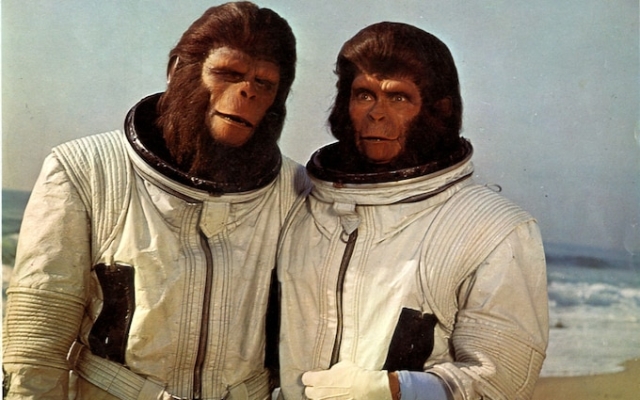 Roddy McDowall and Kim Hunter in the film “Escape from the Planet of the Apes” Photo: Alamy
Roddy McDowall and Kim Hunter in the film “Escape from the Planet of the Apes” Photo: Alamy
Charlton Heston didn't want to go back to Planet of the Apes. The original film, released in 1968, became an unexpected and extraordinary hit. But in those days, Heston later said, making a sequel «was considered tasteless.» However, Twentieth Century Fox was on the verge of bankruptcy. The studio needed a hit. Another ape movie was needed: Beneath the Planet of the Apes, which hit theaters in June 1970.
Heston was persuaded to return — blamed on it by a desperate studio boss — but only on the condition that Heston's character be killed off. Heston did not stop there. He wanted to destroy the entire planet with an atomic bomb. To hell with them all.
But even the destruction of the Earth could not stop them from, well, let's say, monkeying around in search of new sequels. Indeed, Beneath the Planet of the Apes was one of the first of its kind, primitive blockbuster sequels that started the evolution of sequel-making.
The series, produced by Arthur P. Jacobs, spawned four profitable sequels in as many years—all interesting, if sometimes strange—and became an unintentional template for movie franchises: sequels, television spin-offs, and merchandise. And in doing so, we're faced with the same problems that many future sequels will face: stars don't want to return, budgets are being cut, and writers are being written out of creative corners.
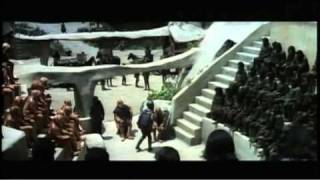
“I first saw Planet of the Apes when I was eight years old,” says Edward Gross, co-author of the new two-book series The Unofficial Oral History of the Planet of the Apes. “In those days, you didn't know there was a new movie coming out until you saw the trailer or the poster. There was no internet or publications talking about it. Suddenly you are in a movie theater and see the trailer for Conquest of the Planet of the Apes. Oh my God!»
As the franchise's latest evolution, Kingdom of the Planet of the Apes, hits theaters, the 1970s sequels continue to be as influential as the original film. However, in the time of Beneath the Planet Monkeys» the original film — especially the Statue of Liberty twist ending (it was Earth all along!) — cast a big shadow.As described in the book Return to the Planet of the Apes by Larry Landsman, Joe Russo and Edward Gross, various ideas were discussed. Pierre Boulle, the author of the original Planet of the Warblers novel, has written a version called Planet of the Men, in which Dr. Zaius will turn into a regular old orangutan. «The Twilight Zone» creator Rod Serling, who wrote the first film and came up with the story of the Statue of Liberty, came up with the idea of Heston's character trying to bring back humanity.
However, Serling was unavailable, so British writer Paul Dehn, screenwriter of Goldfinger, was hired. He suggested that the sequel should start from the end of the original film. What was under the Statue of Liberty? The ruins of New York and the survivors of a nuclear war that, as it turned out, destroyed most of humanity. (That makes sense. It always seemed a little silly — even in a movie about talking chimpanzees — that all that was left of New York in the original film was half a statue.)
 Charlton Heston in the film Beneath the Planet of the Apes Photo: Alamy
Charlton Heston in the film Beneath the Planet of the Apes Photo: Alamy
Meanwhile, associate producer Mort Abrahams was fixated on creating a visual shock that would rival the Statue of Liberty display. The result was the creation of a third species on the planet — humanoid mutants descended from survivors of a nuclear war 2000 years ago. They live in the underground ruins of New York and worship an unexploded Alpha Omega nuclear missile. The moment of shock comes when they tear off their human masks and reveal their true appearance: disgusting, sinewy, ham-like faces.
“Mort Abrahams invented mutants,” says Gross. “Many people tried to talk him out of the idea, but it didn’t work. He insisted!” Another idea, about a half-human, half-ape child, made it to makeup tests but was rejected due to its hint of bestiality.
The man at the top—Fox production chief Richard Zanuck—was more interested in one man than in mutants or apes: Charlton Heston. As detailed by Aubrey Solomon in his book Twentieth Century Fox: A Corporate and Financial History, the studio's losses in 1970 were $77.7 million. Julie Andrews' musical «Star!» Twentieth Century Fox wasn't alone. Other studios were suffering in 1970. According to Solomon, only one of the eight films recouped its cost. Fox's troubles eventually led to Zanuck's father, Darryl Zanuck — the studio boss — overthrowing his own son in a humiliating public power struggle.
Meanwhile, Richard Zanuck persuaded Heston to return as Taylor, the stranded astronaut from the first Apes film. Sequels were derided at the time — certainly not in the spirit of the studio pictures starring Charlton Heston — but Zanuck reminded Heston that he had taken a chance with the original, which was a financial risk and, on paper, a rather ridiculous one. Now he needed Heston's service. “If Charlton Heson signed on for Planet of the Apes today, he would sign on for six films,” says Gross.
It was decided that Heston would appear at the beginning of the film and then return at the end to be killed off. Heston's place in the title role was taken by James Francis (who, to be fair, looks a lot like Heston). Maurice Evans returns as nerdy orangutan statesman Dr. Zaius. But others resisted. Kim Hunter, who played chimpanzee doctor Zira, said, «I didn't want to go back and do it again while I was alive,» although she did eventually return. Roddy McDowall, who became the real star of the series as Cornelius and Caesar, was unavailable — replaced in Below by David Watson — while director Franklin J. Schaffner left to direct Patton. Instead, Ted Post, director of Hang 'Em High, took the helm.
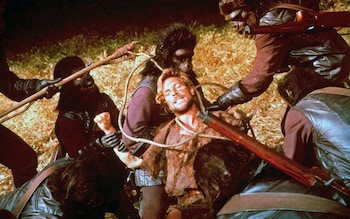 James Francis in the film “Beneath the Planet of the Apes” Photo: Alamy
James Francis in the film “Beneath the Planet of the Apes” Photo: Alamy
No one was happy with the script, including Ted Post and James Francis, who himself was enthusiastic about rewriting it. Post had other disappointments. The budget was cut in half, from $5 million to $2.5 million. “They cut the budget for every one of them,” Gross explains. “Now they will invest more money in the continuation — the more the better! Although it doesn't always work that way. The formula back then was: your sequel will be different from the original in many ways, so the budget is adjusted, so the budget for each sequel is reduced.”
Heston was also unhappy during filming. As noted in Return to the Planet of the Apes, he described the sequel in his diary as «my promised work» and admitted that he was «beginning to regret it.» It was the first film I've ever made in my life that I had no enthusiasm for.
Beneath the Planet of the Apes is more weird than it is bad — somewhere between esoteric science fiction and just a search for any old nonsense. There's some good action sequences involving gorillas on horses chasing people — exactly what you want from Planet of the Apes — with disturbingly jarring visuals: the apocalyptic ash of New York City and crucified apes upside down and burning. By the time the mutants rip their faces off and sing «Everything's Bright and Beautiful» to the atomic bomb, she's already gone crazy.
The ending is grim, part of the Apes tradition, as all the heroes are shot and Heston's Taylor detonates the Alpha Omega bomb. “Tell me a Planet of the Apes that doesn’t have a dark ending,” Gross laughs. Heston took responsibility for pressing the button. “Heston always claimed it was his idea,” Gross says. “He really hated the idea of doing this movie. He felt that he had nothing else to play at except, as he put it, “adventures among the monkeys.” It was his way of saying “there are no more sequels.” It didn’t work that way!”
 Roddy McDowall in the makeup chair for Escape from the Planet of the Apes Photo: Alamy
Roddy McDowall in the makeup chair for Escape from the Planet of the Apes Photo: Alamy
Beneath the Planet of the Apes opened in May 1970. It earned $19 million, which, given its smaller budget, made it another source of income for Fox. Even as the world was destroyed, writer Paul Dehn received a telegram that said: «The monkeys exist, a sequel is required.» The result was Escape from the Planet of the Apes, released exactly one year later.
Sequels often require creativity and undoing decisions made in previous installments. Back to the Future 2 had to come up with a plot in the future involving Marty McFly's children — due to a throwaway joke at the end of the original («They're your kids, Marty! Something needs to be done about your kids!») — while Marvel imported the laziest plot device in comics, the multiverse, to bring popular characters back from the dead.
Dan comes up with a clever idea: Zira and Cornelius (again played by Roddy McDowall), as well as a third chimpanzee, Dr. Milo (Sal Mineo), escape on Taylor's spaceship just before it explodes and are sent back to 1970s Los Angeles.
In the first scene, a spaceship crashes into the sea. The army rushes to meet the astronauts, who exit the ship and remove their helmets, revealing that they are in fact chimpanzees. Although Mort Abrahams had left by this point—replaced as associate producer by Frank Capra Jr. (son of the It's a Wonderful Life director)—the opening scene of Escape from the Planet of the Apes is as close as the series gets to recreating what A Statue of Liberty moment punctuated by Jerry Goldsmith's score. Director Don Taylor, who took the reins for «Prison Break,» recalls that the preview audience burst into applause when the space monkeys took off their helmets.
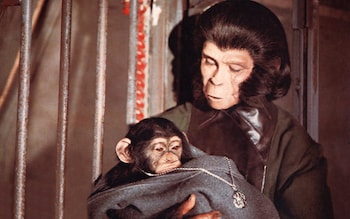 Kim Hunter in the movie “Escape from the Planet of the Apes” Author: Alami
Kim Hunter in the movie “Escape from the Planet of the Apes” Author: Alami
There's a stereotype that TV shows go into space when they run out of ideas. The opposite may be true: sci-fi series that begin in space or sci-fi settings return to modern Earth (see the humpback whale rescue antics of Star Trek IV: The Voyage Home or The Arrival of Red Dwarf). come up with ways to return to Earth once every two weeks).
“In this case, it was a financial decision—they were forced to do something cheaper,” Gross says. “If you're going to make a sequel after the Earth explodes, you either go to another planet or you take them to 1970s Los Angeles and your set is already done. What they came up with turned out to be a creative solution that worked very well. I don't think anyone expected the Escape to be as good as it is.»
Of course, it was cheaper, with a budget of up to $2 million. The producer only had to make up three chimpanzees, as well as a cunning gorilla in a human costume who strangled Dr. Milo to death. But this is also a sharp idea. Cornelius and Zira are initially locked up and experimented upon before Zira discovers she can speak, leading to them being brought before the Presidential investigation. — Is the other one speaking? — asks the examiner, pointing to Cornelius. “Only when she lets me,” Cornelius says, looking at his wife—a bit of ironic sexism that draws rapturous applause.
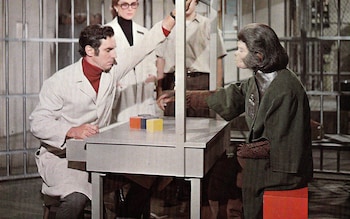 Escape from the Planet of the Apes By Alami
Escape from the Planet of the Apes By Alami
In a story that seems equally prophetic in the age of TikTok, chimpanzees become celebrities — they get drunk and dine in high society and dress in fashionable clothes. It's the closest the film gets to Pierre Boulle's original book, which introduces a human astronaut to modern ape society as a new talking pet — but with the roles reversed.
When humans learn that apes will one day dominate the planet—and that Zira is actually pregnant with a chimpanzee who could overthrow humanity—the apes become a threat. “Prison Break starts with this sweet, light comedy about monkeys turned celebrities,” says Gross. “It takes a dark turn when they end up being hunted and killed.”
Indeed, the ending is ominous: Cornelius and Zira — and their newborn child — are shot to death. Incredibly, it surpasses the end of the previous film — it manages to outshine the actual end of the world. However, we learn that their child has been switched with a circus chimpanzee. The smart baby chimpanzee is alive.
Escape from the Planet of the Apes was another success — Roddy McDowall's favorite film and a highlight of the Apes sequels. However, there was a feeling that more money could be made from this. Fox's marketing company supported it poorly, and Don Taylor thought he was offended by the disappointing weirdness of Beneath the Planet of the Apes.
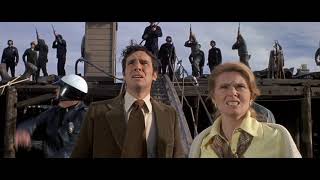
“Prison Break” occupies a curious place in the series—sequel, prequel, and origin story. Cornelius explains the apes' backstory at one point. The virus killed domestic cats and dogs, so people took monkeys as pets. But humans treated the monkeys as slaves, so the monkeys rebelled after the first monkey told the humans “No.” In the next film, Cornelius and Zira's son, Caesar, leads a rebellion that founds the ape society. The backstory is loosely recreated in the modern reboot series, which began with 2011's Rise of the Planet of the Apes and stars Andy Serkis as Caesar, shot in motion. Other modern reboots erase previous sequels, such as the Halloween or Terminator reboots, but the recent Apes films draw their lore from the sequels as much as they do from the original.
After «Escape» they immediately started talking about a fourth film. Written once again by Paul Dehn and directed by J. Lee Thompson (director of The Guns of Navarone), Conquest of the Planet of the Apes was released in theaters in June 1972. The action takes place 20 years later: the apes are enslaved by a totalitarian regime, and so is Caesar. played by Roddy McDowall — hides his identity and intelligence. Trapped in a system of monkey slavery, he leads a rebellion.
There's a dark, retro weirdness to Conquest: a futuristic fascist state built in the style of the 1970s, where humans in a sort of Nazi uniform mock monkeys—taunting them with bananas and then shooting them with flamethrowers—under vibrating, kaleidoscopic lights. Despite some good eggs in ape movies, people demand their demise at every turn. The torture scenes of the apes are strangely impressive — especially Caesar being electrocuted. Literally darker. Many of them were taken at night to hide the ever-cheaper monkey masks.
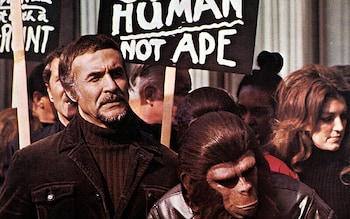 Ricardo Montalban and Roddy McDowall in Conquest of the Planet of the Apes Photo: Alamy
Ricardo Montalban and Roddy McDowall in Conquest of the Planet of the Apes Photo: Alamy
The apes go from serving drinks (bad) to their human masters and shining shoes (also bad) to revolutionizing the use of weapons. The scenes of rioting between apes and humans are still strikingly violent and reminiscent of the Watts race riots of 1965. However, after previews, the riot scenes were toned down. “I remember seeing another option,” Gross says. “When the monkeys fought back, there was a lot of blood—a lot of killing of people. People were terrified: “Are we going to provoke more violence?”
It's surprising that Planet of the Apes works so well with social consciousness and political allegories — from the original's morality play to the reality-based riots, through its less-than-subtle recreation of the Vietnam protests («Pay for peace, not war,» pacifist chimpanzees beg the militaristic gorillas). Monkeys hold up a mirror to humanity, sometimes showing man at his most brutal.
At the end of Conquest, Caesar makes a searing speech declaring that the apes will take control of the planet from humans: “And that day is now!” Initially, his army of rebel gorillas beat to death the governor who was torturing the apes. But the scene was considered too strong. With neither time nor money for reshoots, McDowell recorded several additional lines, eventually making a statement about compassion for people. The lines at the top of the scene were poorly dubbed — a complete contrast to what Caesar had said just a minute ago.
The original ending, included on the Blu-ray edition, features McDowell's most glorious moment as Caesar. “What he does with this character is amazing,” Gross says. “He conveys so much emotion through makeup. It amazed me. Even the poorly dubbed version.” There's a darkness to Caesar that carries over into Andy Serkis' rebooted version.
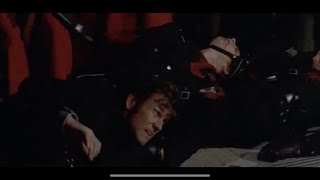
Conquest of the Planet of the Apes brought in another $9.7 million on a $1.7 million budget and led to the final film of the original series, Battle for the Planet of the Apes, released in June 1973. Even before production began, it was clear that Battle would be the end. “Everyone knew it was over,” Gross says. “I think the diminishing returns have almost completely disappeared, although there were still profits.” He adds: “Conquest had the vision and the scale. I think everyone was burned by Battle.»
With a budget of just $1.2 million, the ape's makeup isn't quite up to par (modern advances in HD haven't spared the apes in the background in any of the sequels). The script was passed between writers, and J. Lee Thompson, who returned to direct, was not unhappy with the finished version. “It was the fifth movie, and it wasn’t very good,” he later told Gross and his co-writers. “The battle is weak,” Gross says. “Actually, he is weak. This is a children's film. I guess they wanted to go in the opposite direction of the Conquest, which is so dark.»
The film takes place after a nuclear war has destroyed civilization. Caesar has established a colony of apes living somewhat in harmony with a handful of humans, although the gangster, thick-headed gorillas are up to no good. Survivors of nuclear war will then go out to fight (economical) war. It feels like a movie made for Sunday afternoon television, even though it depicts an ape-versus-man struggle that has been around for about 2,000 years by this point.
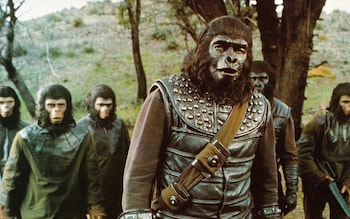 Battle for the Planet of the Apes Author: Alami
Battle for the Planet of the Apes Author: Alami
Caesar also breaks the most important rule of the ape species — «an ape must never kill an ape» — when he fights to the death with a gorilla named Aldo. The fight is recreated in the 2014 film Dawn of the Planet of the Apes, as Andy Serkis' Caesar battles the peace-hating misanthrope Koba, played by Toby Kebbell.
A 14-episode television series followed in 1974 and an animated series, Return to the Planet of the Apes, in 1975. There were attempts to remake Planet of the Apes in the 1980s and 1990s, with various directors being brought in at various stages: Adam Rifkin, Oliver Stone, Chris Columbus, James Cameron and Arnold Schwarzenegger. The definitive remake, directed by Tim Burton, or «reimagining» as it was called, was released in 2001. Few people have anything good to say about him. “The makeup looks great!” says Gross.
When Beneath the Planet of the Apes was released in 1970, the closest equivalent was James Bond, although Bond always existed on its own terms — individual adventures were sold on the grounds that they were bigger, weirder, more expensive with each contribution. The Monkees films were a precursor to the more common form of sequels: squeezing every possible dollar out of a proven movie brand. But in the case of Planet of the Apes, they represent more than just apes in creepy masks: nuclear war, murder, morality, politics and the wilder impulses of humanity. Perhaps that's why the latest films have become some of the smartest blockbusters in recent years.
As Edward Gross says of the Planet of the Apes sequels: «They deal with some heavy stuff.»























































Свежие комментарии